
Fortinet FortiMail 200F
Comprehensive Messaging Security

4 x 10/100/1000 ports, 1 x 1TB HDD
List Price:
Our Price: $3,534.44
List Price:
Our Price: $5,251.00
List Price:
Our Price: $8,751.00
List Price:
Our Price: $12,252.00
List Price:
Our Price: $6,476.00
List Price:
Our Price: $12,427.00
Click here to jump to more pricing!
Overview:
Powerful, Scalable Email Security Protection Available in an Array of Deployment Models
With best-in-class performance validated by independent testing firms, FortiMail delivers advanced multi-layered protection against the full spectrum of email-borne threats. Powered by FortiGuard Labs threat intelligence and integrated into the Fortinet Security Fabric, FortiMail helps your organization prevent, detect, and respond to emailbased threats including spam, phishing, malware, zero-day threats, impersonation, and Business Email Compromise (BEC) attacks.
Email security solutions for organizations that prefer full control and management over their email security infrastructure.
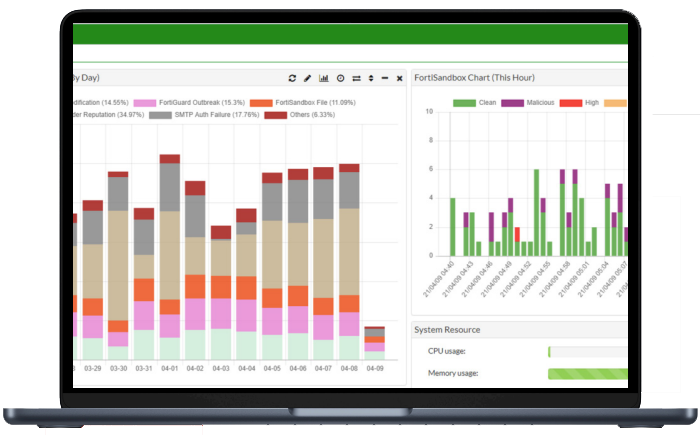
Check the box against:
- Spam
- Phishing
- Spear-phishing and whale phishing
- Malicious Attachments and URLs
- Ransomware
- Zero-day Threats
- Impersonation
- Business Email Compromise (BEC)
Highlights:
- Protection against email-borne threats
- Validated performance
- Fabric-enabled email security
- Powered by FortiGuard Labs
Features:
Protection Against Email-borne Threats
Powerful anti-spam and anti-malware are complemented by advanced techniques like outbreak protection, content disarm and reconstruction, sandbox analysis, impersonation detection, and other technologies to stop unwanted bulk email, phishing, ransomware, business email compromise, and targeted attacks.
Validated Performance
Fortinet is one of the only email security vendors to consistently prove the efficacy of FortiMail through independent testing. FortiMail earned a 99.99% Spam Catch Rate from Virus Bulletin.
Fabric-enabled Email Security
FortiMail is integrated with Fortinet products as well as third-party components help you adopt a proactive approach to security by sharing IoCs across a seamless Security Fabric. It also enables advanced and complementary email security protection for Microsoft 365 and Google Gsuite Cloud email through API-level integration.
Powered by FortiGuard Labs
Fortinet FortiMail is powered by threat intelligence and FortiGuard AI-powered Security Services like antivirus, virus outbreak protection, and antispam, from FortiGuard Labs. With visibility across 600,000 customer environments worldwide, FortiGuard Labs is one of the preeminent threat research teams in existence.
Proactive Email Security
FortiMail addresses the full spectrum of risks that email poses to organizations, fortified by FortiGuard Labs’ global visibility and intelligence on the latest threats.
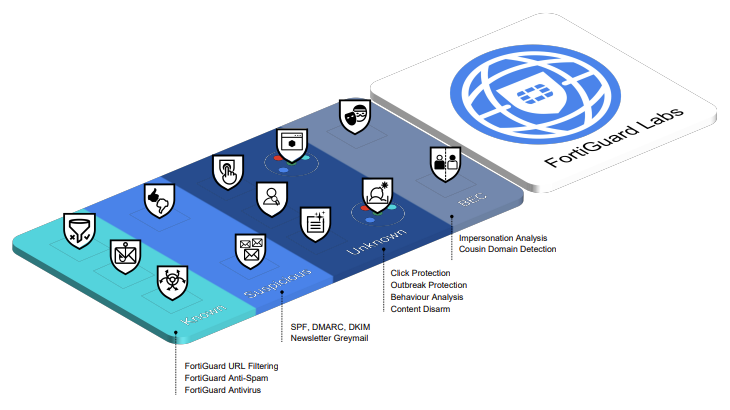
Multi-Layered Anti-Spam
Multiple sender, protocol and content inspection techniques shield users from spam and junk mail. Using a combination of reputation analysis, connection filtering, authentication and recipient verification methods allows for fast and accurate email protection. Checks include IP, domain, sender, SPF, DKIM, DMARC and geographical restrictions.
Finally, message structure and content are analyzed based on the digital signature, keywords in context, image analysis, embedded URIs, and more advanced techniques such as behavior analysis and spam outbreak protection. Working together, these techniques consistently identify and block a verified 99.99% of spam in real-world conditions.
Powerful Anti-Malware
Combining multiple static and dynamic technologies that include signature, heuristic, and behavioral techniques along with virus outbreak prevention, FortiMail protects against a wide range of constantly evolving threats.
Advanced Threat Protection (ATP)
For an even stronger defense against the very latest threat classes like business email compromise and targeted attacks, FortiMail offers optional content disarm and reconstruction, sandbox analysis, sophisticated spoof detection, and more.
Integrated Data Loss Prevention
A robust set of capabilities for data loss prevention and email encryption safely deliver sensitive emails and protect against the inadvertent loss of data. These features facilitate compliance with corporate policies and industry regulations.
Intuitive Controls
Real-time dashboards, rich reporting, centralized quarantine and simple to use end-user controls allow organizations to get running and realize value quickly. An intuitive user interface combined with flexible MTA and mail-handling capabilities give full visibility and control over email traffic.
Integration with the Fortinet Security Fabric
The future of email security is platform- or fabric-enabled to counter the growing sophistication of threats and multi-vector campaigns. As part of the Fortinet Security Fabric, Indicators of Compromise and other telemetry can be shared for enhanced security across your entire security infrastructure.
IT and security teams are able to more completely connect the dots to identify multi-vector campaigns by sophisticated actors. In addition, intensive and repetitive workflows including response can be automated to reduce the burden on security operations teams.
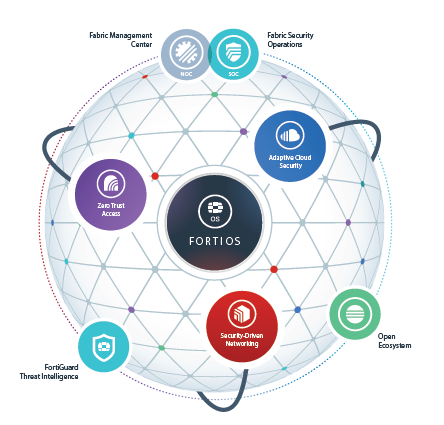
Intuitive Email Management
Real-time dashboards, rich reporting, centralized quarantines, and end user controls along with full MTA and mail-handling capabilities provide organizations full visibility and easy control over email traffic.
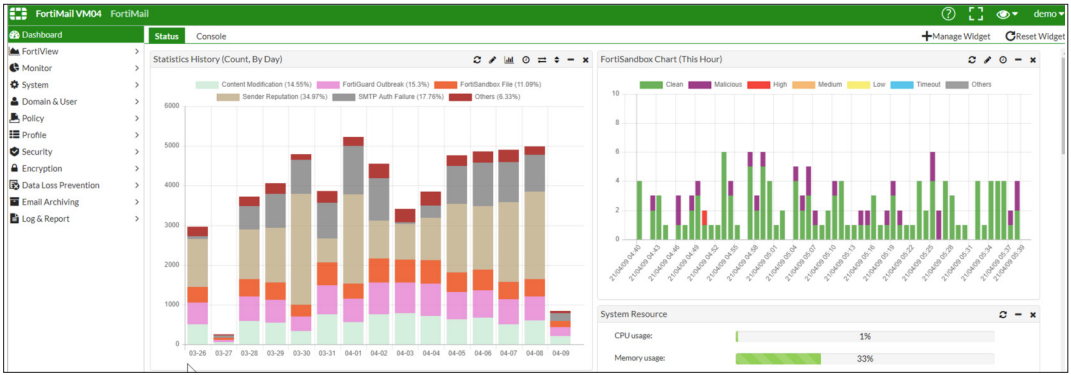
Easy-to-Use Configuration
Easy-to-use configuration controls make setting up and managing email security – even advanced security capabilities - easy for organizations of all sizes and use cases
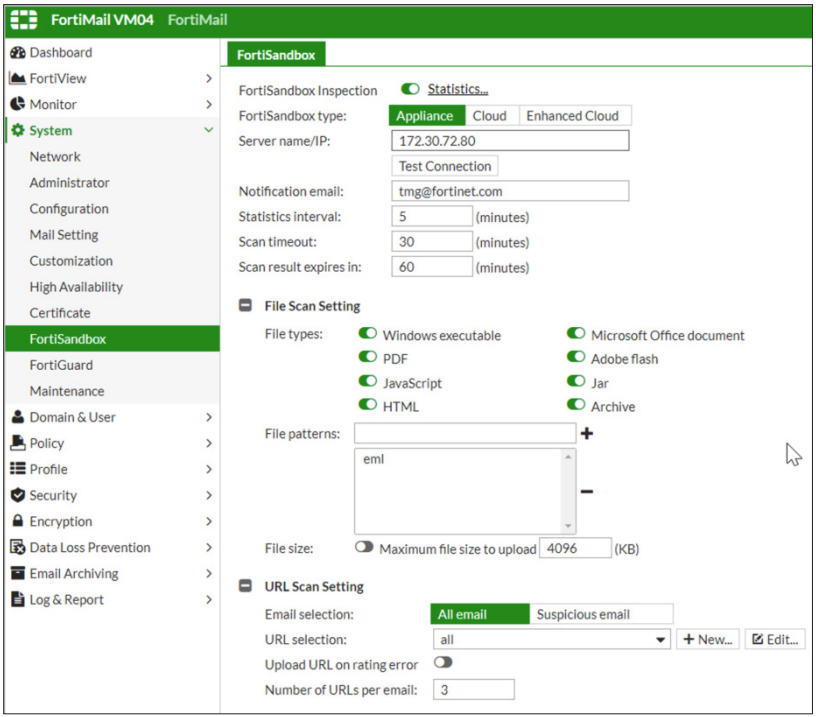
High Performance, Flexible Deployment
Scale easily to handle millions of messages per hour. Serving organizations of all sizes, Fortinet provides a wide range of deployment models and operation modes to best match your organization’s email security needs.
Deployment Models
Appliances and Virtual Machines
FortiMail appliances and virtual machines are for organizations that prefer full control and management over their email security infrastructure for on-premise and cloud use cases
FortiMail Cloud
FortiMail Cloud for organizations that want simple, easyto-use email security as-a-service for both on-premise and cloud-based email services.
Operation Modes
Gateway Mode
Provides inbound and outbound proxy mail transfer agent (MTA) services for existing email gateways. A simple DNS MX record change redirects email to FortiMail for analysis. FortiMail then relays safe email to its destination email server for delivery.
Microsoft and Google Cloud Email API Integration
FortiMail can be deployed out of line to simplify deployment, so no MX record change is required, and leverage the native Microsoft and Google APIs to deliver threat detection and post-delivery message clawback. Broad flexibility is possible with clawback to create policies that address compliance or unique business requirements, such as building search parameters based on keywords, file name, or content type. These capabilities can serve as powerful complements to native Microsoft and Google security features to bolster overall efficacy and reduce risk.
Transparent Mode
Transparent mode eliminates the need to change the DNS MX record, or to change the existing email server network configuration. Transparent mode is particularly appealing for service providers that want to extend email security services to their customer bases. Not available with FortiMail Cloud.
Server Mode
The FortiMail device acts as a standalone messaging server with full SMTP email server functionality, including flexible support for secure POP3, IMAP, and WebMail access.
Additional Add-on Capabilities
Email Continuity
Email Continuity for FortiMail Cloud is designed to protect valuable productivity by providing emergency mailbox services when organizations experience an outage of their email services.
Dynamic Image Analysis Service
Protects your organization and employees against inappropriate and sexually explicit images
Integrations with Fortinet Solutions

Deployment Options:
Choose from three modes of deployment — Transparent, Gateway, or Server mode – to meet your specific email security requirements, while minimizing infrastructure changes and service disruptions:
Gateway Mode: Provides inbound and outbound proxy mail transfer agent (MTA) services for existing email gateways. A simple DNS MX record change redirects email to FortiMail for antispam and antivirus scanning. The FortiMail device receives messages, scans for viruses and spam, then relays email to its destination email server for delivery.
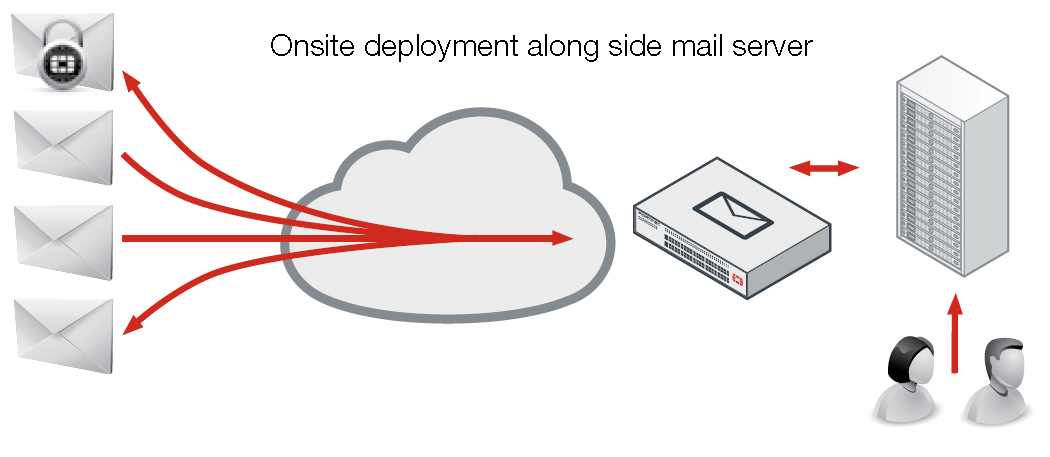
Transparent Mode: Each network interface includes a proxy that receives and relays email. Each proxy can intercept SMTP sessions even though the destination IP address is not the FortiMail appliance. FortiMail scans for viruses and spam, then transmits email to the destination email server for delivery. This eliminates the need to change the DNS MX record, or to change the existing email server network configuration.
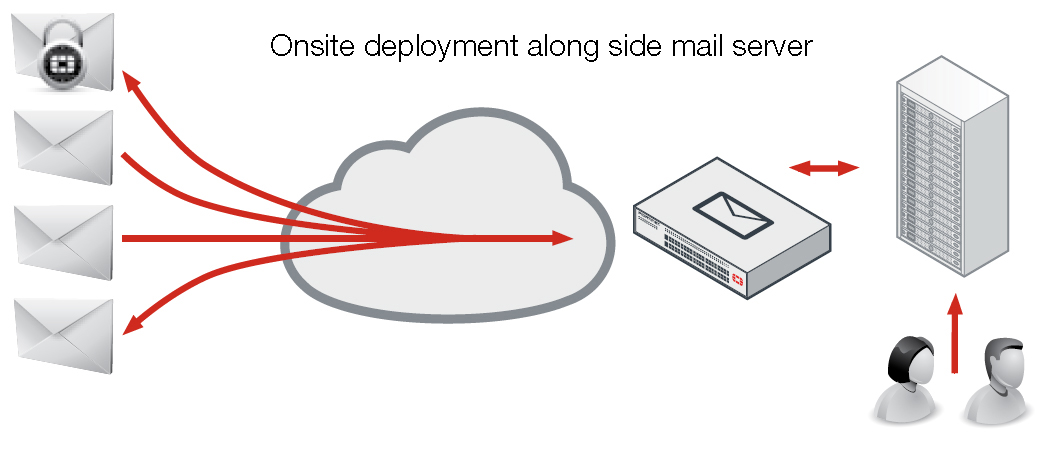
Server Mode: The FortiMail device acts as a stand-alone messaging server with full SMTP email server functionality, including flexible support for secure POP3, IMAP and WebMail access. FortiMail scans email for viruses and spam before delivery. As in Server mode, external MTAs connect to FortiMail, allowing it to function as a protected server.
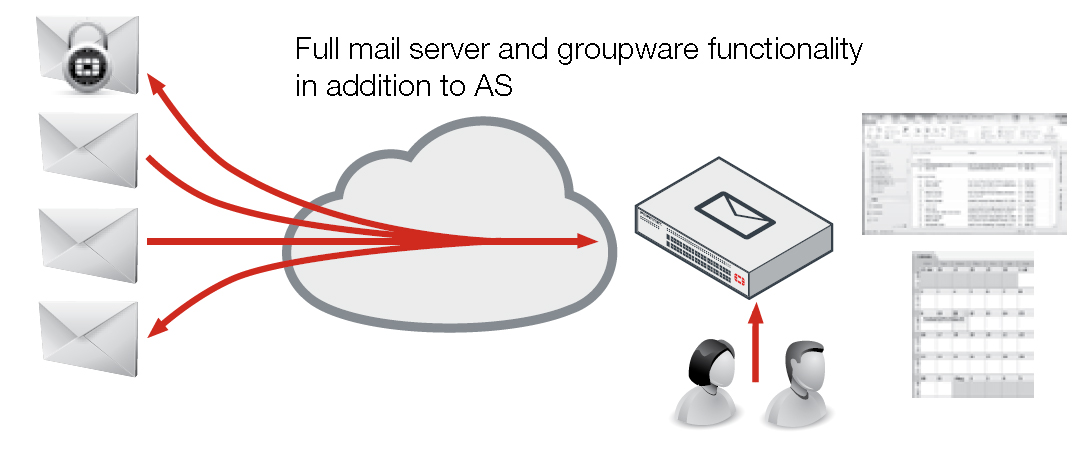
Identity-Based Encryption (IBE) IBE allows FortiMail to deliver confidential and regulated email securely — without requiring additional hardware, software user provisioning, or extra license fees. Use IBE to eliminate paper-based communications and reduce costs.
Policy-Based Encryption: Automatically encrypt messages for compliance, based on content or recipient.
Push or Pull Mode: Use Push, Pull, or a combination of modes to meet your requirements.
Easy to Deploy, Use, and Manage: Deploy IBE in any mode, including Transparent mode, without user provisioning or additional hardware or software.
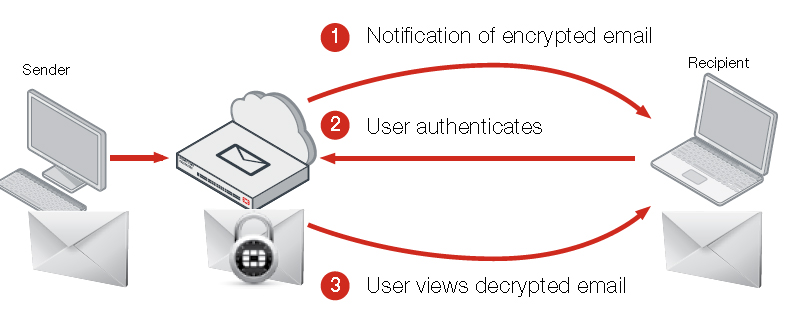
Specifications:
| FortiMail 200F | FortiMail 400F | FortiMail 900F | FortiMail 900G | |
|---|---|---|---|---|
| Recommended Deployment Scenarios | ||||
| Small businesses, branch offices, and organizations | Small to midsized organizations | Mid to large enterprise, education, and government departments | Mid to large enterprise, education, and government departments | |
| Hardware Specifications | ||||
| 10/100/1000 Interfaces (Copper, RJ45) | 4 | 4 | 4 | 4 |
| SFP Gigabit Ethernet Interface | — | — | 2 | 2 |
| SFP+ 10 Gigabit Ethernet Interface | — | — | — | — |
| Redundant Hot Swappable Power Supplies | — | — | ||
| Storage | 1× 1 TB | 2× 1 TB | 2× 2 TB (2× 2 TB Optional) | 2× 4 TB (2× 4 TB Optional) |
| Secure Encrypted Drives (SED) | — | — | — | |
| RAID Storage Management | Software 0, 1 | Hardware 0, 1, 5, 10, Hot Spare (Based on Drive Count) | Hardware 0, 1, 5, 10, Hot Spare | Hardware 0, 1, 5, 10, Hot Spare |
| Memory | 4 GB | 8 GB | 16 GB | 16 GB |
| Form Factor | Rack Mount, 1U | Rack Mount, 1U | Rack Mount, 1U | Rack Mount, 1U |
| Trusted Platform Module (TPM) | ||||
| Power Supply | Single | Single (Dual Optional) | Dual | Dual |
| System Specifications | ||||
| Protected Email Domains* | 20 | 70 | 500 | 500 |
| Recipient-Based Policies (per Domain / per System) | 60 / 300 | 400 / 1500 | 600 / 2000 | 600 / 2000 |
| Server Mode local mailboxes | 150 | 400 | 1500 | 1500 |
| Antispam, Antivirus, Authentication, and Content Profiles (per Domain / per System) | 50 / 60 | 50 / 200 | 50 / 400 | 50 / 400 |
| Data Loss Prevention | — | |||
| Centralized Quarantine | — | |||
| Microsoft 365 and Google G‑suite Email API Integration | — | Optional | Optional | Optional |
| Performance (Messages/Hour) [Without queuing based on 100 KB message size] | ||||
| Email Routing (per hour)** | 50 K | 250 K | 800 K | 1.3 Million |
| FortiGuard Antispam + Virus Outbreak (per hour) | 40 K | 200 K | 500 K | 900 K |
| FortiGuard Enterprise ATP (per hour) | 30 K | 150 K | 400 K | 650 K |
| Cloud API Performance (Messages/Hour) [Without queuing based on 100 KB message size] | ||||
| Email Routing (per hour)** | 18 K | 83 K | 241 K | 320 K |
| FortiGuard Antispam + Virus Outbreak (per hour)** | 14 K | 72 K | 170 K | 235 K |
| FortiGuard Enterprise ATP (per hour)** | 12 K | 58 K | 148 K | 200 K |
| Dimensions | ||||
| Height x Width x Length (inches) | 1.73×17.24×16.61 | 1.73×17.24×16.38 | 1.75×17.00×27.61 | 1.7×17.2×24 |
| Height x Width x Length (mm) | 44×438×422 | 44×438×416 | 44×438×701 | 44×438×610 |
| Weight | 11.9 lbs (5.4 kg) | 25.0 lbs (11.0 kg) | 33.1 lbs (15.0 kg) | 28.37 lbs (12.87 kg) |
| Environment | ||||
| Power Source | 100–240 V AC, 50–60 Hz | 100–240 V AC, 50–60 Hz | 100–240 V AC, 50–60 Hz | 100–240 V AC, 50–60 Hz |
| Maximum Current | 100 V / 3 A, 240 V / 1.5 A | 100 V / 5 A, 240 V / 3 A | 100 V / 5 A, 240 V / 2.5 A | 6 A / 100 V, 3 A / 240 V |
| Maximum Power Required | 62 W | 113 W | 190 W | 189.4 W |
| Power Consumption (Average) | 51 W | 77 W | 174 W | 165.56 W |
| Heat Dissipation | 245 BTU/h | 418 BTU/h | 681 BTU/h | 646.23 BTU/h |
| Forced Airflow | Front to back | Front to back | Front to back | Front to back |
| Humidity | 5% to 90% non‑condensing | 5% to 90% non‑condensing | 5% to 90% non‑condensing | 5% to 93% non‑condensing |
| Operating Temperature | 32 °F to 104 °F (0 °C to 40 °C) | 32 °F to 104 °F (0 °C to 40 °C) | 32 °F to 104 °F (0 °C to 40 °C) | 50 °F to 95 °F (10 °C to 35 °C) |
| Storage Temperature | –4 °F to 158 °F (–20 °C to 70 °C) | –4 °F to 158 °F (–20 °C to 70 °C) | –4 °F to 158 °F (–20 °C to 70 °C) | –40 °F to 158 °F (–40 °C to 70 °C) |
| Compliance and Cetification | ||||
| Compliance | FCC Part 15 Class A, RCM, VCCI, CE, UL/cUL, CB, RoHS | FCC Part 15 Class A, RCM, VCCI, CE, UL/cUL, CB, BSMI, RoHS | FCC Part 15 Class A, RCM, VCCI, CE, UL/cUL, CB, BSMI, RoHS | FCC Part 15 Class A, RCM, VCCI, CE, UL/cUL, CB, BSMI, RoHS |
| Certification | VBSpam and VB100 rated. Common Criteria evaluation in process (NIAP). NIST CMVP Implementation under test (FIPS140‑3). | |||
* Protected Email Domains is the total number of email domains that can be configured on the appliance. Domain Associations can be used to enable additional domains which share configuration with the primary domain to which they are assigned. Advanced management license increases the protected domain limit by 50%.
** Tested using FortiMail 7.0
Features Summary:
System
- Wide range of deployment and operation options
- On-premise or public or private cloud deployment
- Gateway, Microsoft and Google API connectors, Transparent, and Server Mode
- Inbound and Outbound Inspection
- Support for multiple email domains with per-domain customization
- MSSP multi-tenant support with white label support
- Multi-tier administration
- IPv4 and IPv6 Address Support
- Virtual Hosting using Source and/or Destination IP Address Pools
- SMTP Authentication Support via LDAP, RADIUS, POP3 and IMAP
- LDAP-Based Email Routing
- Per User Inspection using LDAP Attributes on a Per Policy (Domain) Basis
- Geographic IP location-based policy
- Comprehensive Webmail Interface for Server Mode Deployments and Quarantine Management
- Mail Queue Management
- Multiple Language Support for Webmail and Admin Interface
- SMTP RFC Compliance
- Modern HTML 5 GUI
- Independently tested by SELabs, and Virus Bulletin
- Compatibility with cloud services e.g. Microsoft 365, Google Workspace, Amazon AWS, and Microsoft Azure
- DNS-based Authentication of Named Entities (DANE) support
Antispam
- FortiGuard Antispam Service
- Sender and domain reputation
- Spam and attachment signatures
- Dynamic heuristic rules
- Outbreak protection
- Full FortiGuard URL Category Filtering includes
- Spam, malware and phishing URLs
- Pornographic and adult URLs
- Newly registered domains
- Greylisting for IPv4, IPv6 addresses and email accounts
- Local sender reputation (IPv4, IPv6 and End Point ID-based)
- Behavioral analysis
- Integration with third-party spam URI and real-time blacklists (SURBL/RBL)
- Newsletter (greymail) and suspicious newsletter detection
- PDF Scanning and image analysis
- Block/safe lists at global, domain, and user levels
- Support for enterprise sender identity standards
- Sender Policy Framework (SPF)
- Domain Keys Identified Mail (DKIM)
- Domain-Based Message Authentication (DMARC)
- Flexible action and notification profiles
- Multiple system and per-user self-service quarantines
Targeted Attack Protection
- Content Disarm and Reconstruction
- Neutralize Office and PDF documents (remove macros, active content, attachments, and more)
- Neutralize email HTML content by removing hyperlinks / rewrite URLs
- Business Email Compromise (BEC)
- Multi-level anti-spoof protection
- Impersonation analysis
- manual and automatic address impersonation detection
- Cousin domain detection
- URL Click Protect to rewrite URLs and rescan on access
- Integration with FortiIsolator Browser Isolation platform to neutralize browser-based threats
API Integration
- Microsoft 365 and Google Gsuite Email Integration
- Post-delivery threat clawback
- Scheduled scan
- Real-time scanning
- Internal mail scanning
Content Detection
- FortiGuard Antivirus Service detection
- CPRL signature checking
- Heuristic based behavioral detection
- Greyware detection
- FortiGuard Virus Outbreak Protection Service
- Global threat intelligence and data analytics
- Active content detection (PDF & Office Documents)
- Rescan for threats on quarantine release
- Custom file hash checking Mime and file type detection
- Comprehensive data-loss prevention with file fingerprinting and sensitive data detection
- Automatic Windows fileshare and manual upload file fingerprinting
- Healthcare, Finance, personally identifiable information and profanity detection
- Automatic decryption of Archives, PDF and Office Documents using built-in and administrator-defined password lists and word detection within email body
- PDF Scanning and image analysis
- Dynamic Image Analysis Service
- Identify and report on illicit and sexually explicit content
Encryption
- Comprehensive encryption support
- Server to server TLS with granular ciphersuite control and optional enforcement
- S/MIME
- Clientless encryption to the recipient desktop using Identity Based Encryption (IBE)
- Optional Outlook plugin to trigger Identity Based Encryption (IBE)
Management, Logging, and Reporting
- Basic/advanced management modes
- Per domain, role-based administration accounts
- Comprehensive activity, configurations change and incident logging and reporting
- Built-in reporting module
- Detailed message tracking
- Centralized quarantine for large scale deployments
- Optional centralized logging and reporting with FortiAnalyzer
- SNMP support using standard and private MIB with threshold-based traps
- Local or external storage server support, including iSCSI devices
- External Syslog support
- Open REST API for configuration and management
High Availability (HA)
- High availability supported in all deployment scenarios
- Active-Passive mode
- Active-Active configuration synchronization mode
- Quarantine and mail queue synchronization
- Device failure detection and notification
- Link status, failover and redundant interface support
Advanced
- Policy-based e-mail archiving with remote storage options
- Support for Exchange journal archiving
- Advanced Email Server feature set including
- Comprehensive webmail interface
- POP3, IMAP mail access
- Calendaring functions
- Undo Send
- SAML 2.0 SSO and ADFS integration for webmail and quarantine access
Support
- Simple support options with inclusive bundles
- Advanced RMA Support
- Professional services and installation support options
Documentation:
Download the Fortinet FortiMail Datasheet (PDF).

